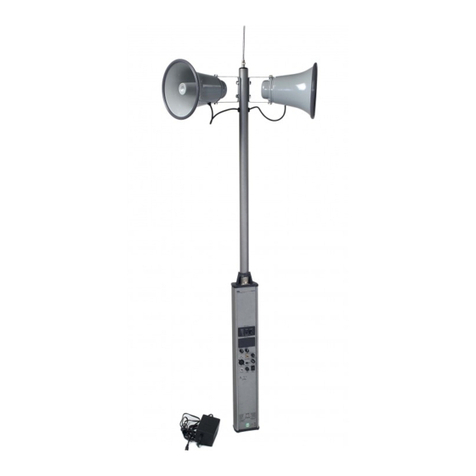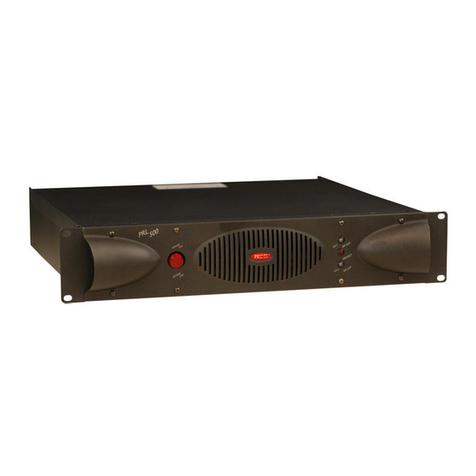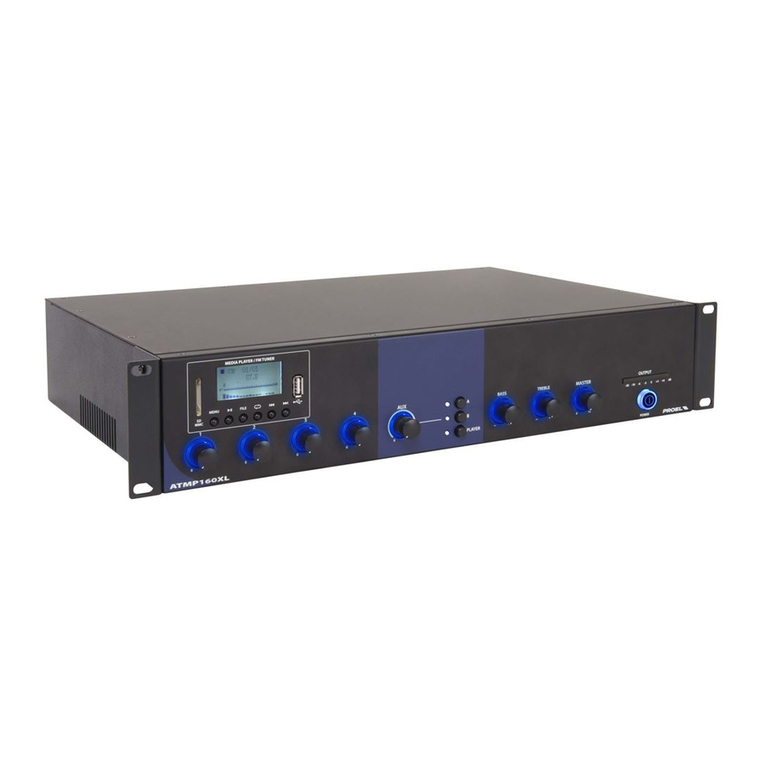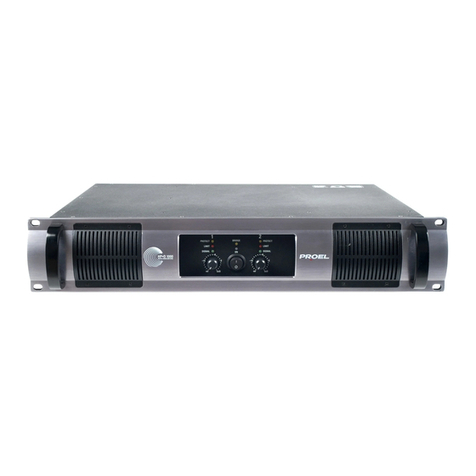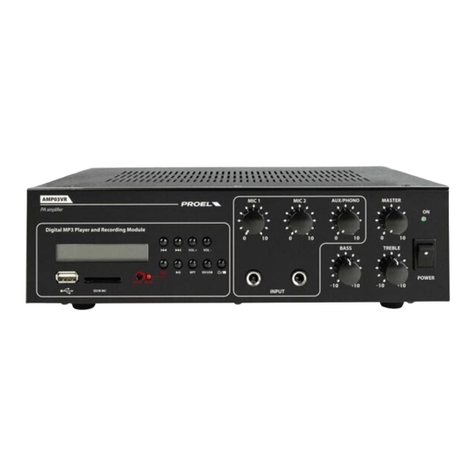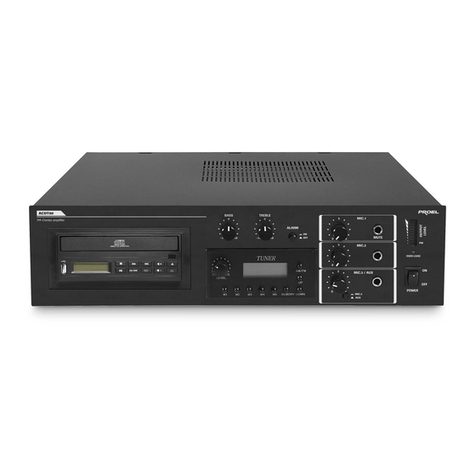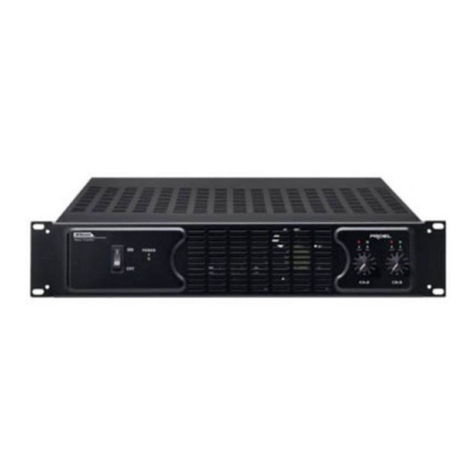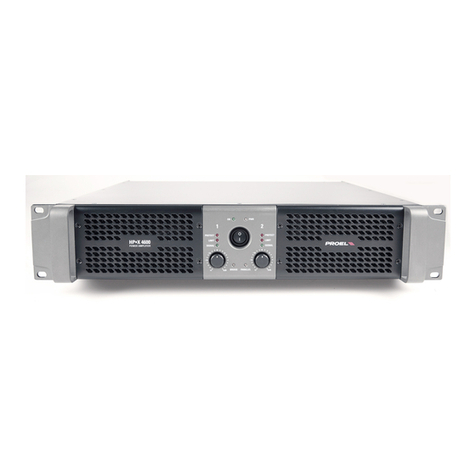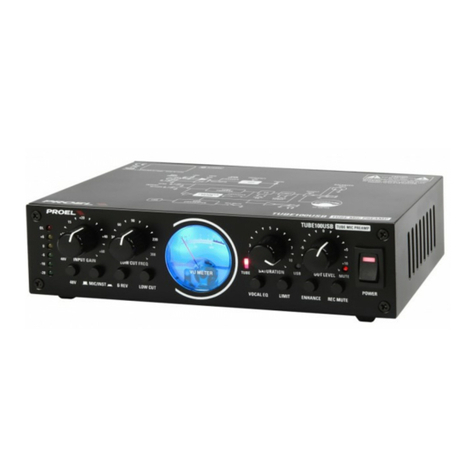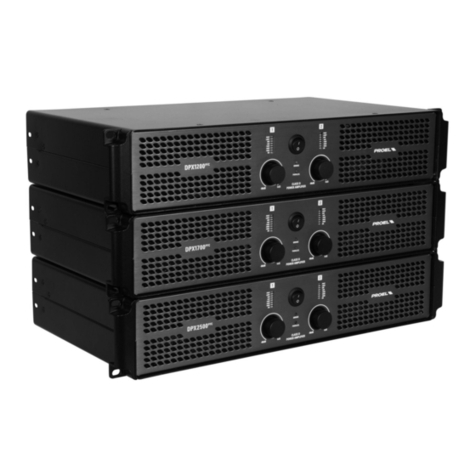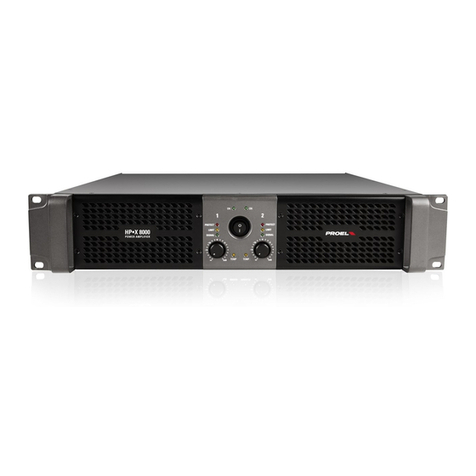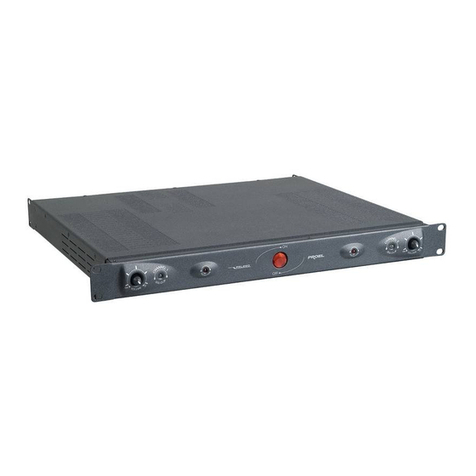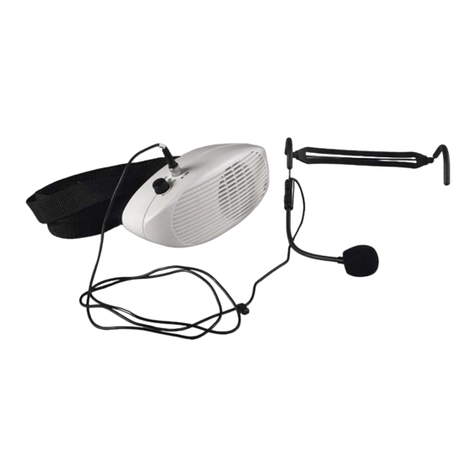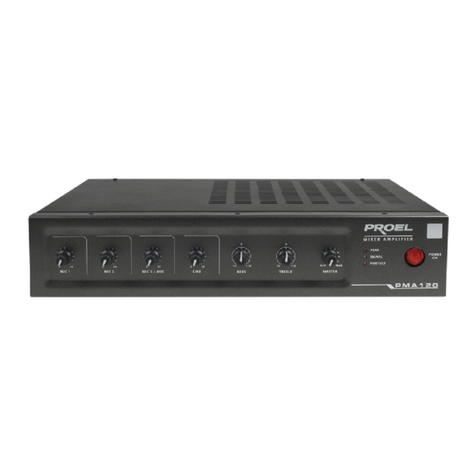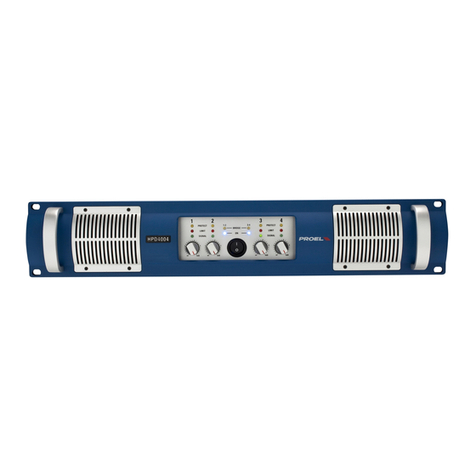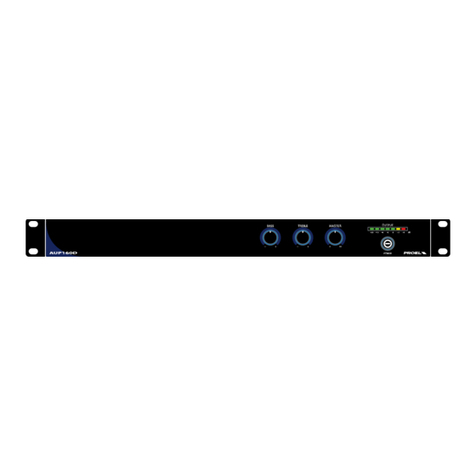4Index
INDEX
FCCCOMPLIANCENOTICE..................................... 2
TECHNICALSPECIFICATIONS................................... 3
SETUP AND RACK MOUNTING (FIG. 1 / 2) ........................ 6
LOUDSPEAKERCABLE......................................... 6
CONNECTIONS............................................... 7
SUGGESTEDCONFIGURATIONS................................. 8
LPNFILTERRESPONSE(FIG.3).................................. 8
CONTROLPANEL(FIG.4)....................................... 9
REARPANEL(FIG.5)........................................... 9
CONFIGURATION EXAMPLES (FIG.6/7/8)......................... 10
SAFETYANDPRECAUTIONS .................................. 11
INCASEOFFAULT........................................... 11
TROUBLESHOOTING ......................................... 11
CECONFORMITY............................................. 12
PACKAGING, SHIPPING AND COMPLAINT . . . . . . . . . . . . . . . . . . . . . . 12
WARRANTY AND PRODUCTS RETURN . . . . . . . . . . . . . . . . . . . . . . . . . . 12
INSTALLATIONANDDISCLAIMER.............................. 12
POWER SUPPLY AND MAINTENANCE . . . . . . . . . . . . . . . . . . . . . . . . . . 12
GENERALINFORMATION ..................................... 13
SETUP AND RACK MOUNTING. . . . . . . . . . . . . . . . . . . . . . . . . . . . . . . . . 13
FRONTPANEL(FIG.4)......................................... 13
REARPANEL(FIG.5).......................................... 14
ADVANCED FEATURES........................................ 16
INDICE
FCCCOMPLIANCENOTICE..................................... 2
SPECIFICHETECNICHE........................................ 3
INSTALLAZIONE A RACK (FIG. 1 / 2). . . . . . . . . . . . . . . . . . . . . . . . . . . . . . 6
CAVO ALTOPARLANTE......................................... 6
CONNESSIONI. . . . . . . . . . . . . . . . . . . . . . . . . . . . . . . . . . . . . . . . . . . . . . . . 7
RISPOSTAFILTROLPN(FIG.3).................................. 8
CONFIGURAZIONISUGGERITE.................................. 8
PANNELLODICONTROLLO(FIG.4)............................... 9
PANNELLOPOSTERIORE(FIG.5)................................. 9
ESEMPI CONFIGURAZIONI (FIG.6/7/8)........................... 10
AVVERTENZE PER LA SICUREZZA .............................. 17
INCASODIGUASTO......................................... 17
PROBLEMATICHECOMUNI.................................... 17
CONFORMITÀCE ............................................ 18
IMBALLAGGIO, TRASPORTO E RECLAMI . . . . . . . . . . . . . . . . . . . . . . . . 18
GARANZIEERESI............................................ 18
INSTALLAZIONE E LIMITAZIONI D’USO . . . . . . . . . . . . . . . . . . . . . . . . . 18
ALIMENTAZIONE E MANUTENZIONE . . . . . . . . . . . . . . . . . . . . . . . . . . . 18
INFORMAZIONIGENERALI.................................... 19
INSTALLAZIONE E MONTAGGIO A RACK . . . . . . . . . . . . . . . . . . . . . . . . 19
PANNELLOFRONTALE........................................ 19
PANNELLOPOSTERIORE...................................... 20
FUNZIONI AVANZATE ........................................ 22
2. . . . . . . . . . . . . . . . . . . . . . . . FCC COMPLIANCE NOTICE
5. . . . . . . . . . . . . . . . . . . . . . . . . . . . . . . . . . . . . . . . . . . . . . . . . . . . . .
6. . . . . . . . . . . . . . . . . . . . . . . . . . . . . . . .(2 / 1 )
6. . . . . . . . . . . . . . . . . . . . . . . . . . . . . . . . . . . . . . . . . . . . . . . . . . . . . . . . . . . . .
7. . . . . . . . . . . . . . . . . . . . . . . . . . . . . . . . . . . . . . . . . . . . . . . . . . . . . . . . . . . .
8. . . . . . . . . . . . . . . . . . . . . . . . . . . . . . . . . . . . . . . . . . . . . . . . . . . . . . .
8. . . . . . . . . . . . . . . . . . . . . . . . . . . . . . . .(3 ) NPL
9. . . . . . . . . . . . . . . . . . . . . . . . . . . . . . . . . . . . (4 )
9. . . . . . . . . . . . . . . . . . . . . . . . . . . . . . . . . . . (5)
10. . . . . . . . . . . . . . . . . . . . . . . . (8 / 7/ 6 )
41 . . . . . . . . . . . . . . . . . . . . . . . . . . . . . . . . . . . . . . . . . . . . . .
41 . . . . . . . . . . . . . . . . . . . . . . . . . . . . . . . . . . . . . . . . . . . . . . . . . . . . . . . .
41 . . . . . . . . . . . . . . . . . . . . . . . . . . . . . . . . . . . . . . . . . . . . . . . . . . . . .
42. . . . . . . . . . . . . . . . . . . . . . . . . . . . . . . . . . . . . . . . . .EC
42 . . . . . . . . . . . . . . . . . . . . . . . . . . . . . . . . . . . . . . . . .
42 . . . . . . . . . . . . . . . . . . . . . . . . . . . . . . . . . . . . . . . . . . . . . . . . . . . . . .
42 . . . . . . . . . . . . . . . . . . . . . . . . . . . . . . . . . . . . . . . . . . . .
42 . . . . . . . . . . . . . . . . . . . . . . . . . . . . . . . . . . . . . . . . . . . . . . . . . . . . . .
43 . . . . . . . . . . . . . . . . . . . . . . . . . . . . . . . . . . . . . . . . . . . . . . . . . . . . . . .
43 . . . . . . . . . . . . . . . . . . . . . . . . . . . . . . . . . . . . . . . . . . . . . .
43 . . . . . . . . . . . . . . . . . . . . . . . . . . . . . . . . . . . . . . . . . . . . . . . . . . . . . . .
44 . . . . . . . . . . . . . . . . . . . . . . . . . . . . . . . . . . . . . . . . . . . . . . . . . . . . . . .
46 . . . . . . . . . . . . . . . . . . . . . . . . . . . . . . . . . . . . . . . . . . . . . . . . . . . . .
INHALT
FCCCOMPLIANCENOTICE..................................... 2
TECHNISCHEDATEN.......................................... 5
RACK-INSTALLATION (ABB. 1 / 2) ............................... 6
LAUTSPRECHERKABEL........................................ 6
ANSCHLÜSSE................................................ 7
EMPFOHLENEKONFIGURATIONEN.............................. 8
FREQUENZGANG FILTER LPN (ABB. 3) . . . . . . . . . . . . . . . . . . . . . . . . . . . 8
REGLER(ABB.4) .............................................. 9
HINTEREBEDIENTAFEL(ABB.5)................................. 9
KONFIGURATIONSBEISPIELE (ABB.6/7/8) ....................... 10
SICHERHEITSHINWEISE...................................... 23
BEIEINEMDEFEKT........................................... 23
HÄUFIG AUFTRETENDE PROBLEME ............................ 23
EG-KONFORMITÄT ........................................... 24
VERPACKUNG, TRANSPORT UND REKLAMATIONEN.............. 24
GARANTIEUNDRÜCKGABE................................... 24
INSTALLATION UND VERWENDUNGSEINSCHRÄNKUNGEN........ 24
STROMVERSORGUNG UND INSTANDHALTUNG .................. 24
ALLGEMEINEINFORMATIONEN................................ 25
RACK INSTALLATION UND MONTAGE . . . . . . . . . . . . . . . . . . . . . . . . . . 25
VORDERE BEDIENTAFEL ...................................... 25
HINTEREBEDIENTAFEL....................................... 26
FORTGESCHRITTENE FUNKTIONEN . . . . . . . . . . . . . . . . . . . . . . . . . . . . 28
INDEX
FCCCOMPLIANCENOTICE..................................... 2
SPÉCIFICATIONSTECHNIQUES................................. 5
INSTALLATION EN RACK (FIG. 1 / 2).............................. 6
CÂBLEHAUT-PARLEUR........................................ 6
CONNEXIONS................................................ 7
RÉPONSEFILTRELPN(FIG.3)................................... 8
CONFIGURATIONSSUGGÉRÉES................................. 8
PANNEAUDECOMMANDE(FIG.4) .............................. 9
PANNEAUARRIÈRE(FIG.5)..................................... 9
EXEMPLES CONFIGURATIONS (FIG.6/7/8)........................ 10
MISESENGARDEDESÉCURITÉ ............................... 29
ENCASDEPANNE........................................... 29
PROBLÈMESCOMMUNS...................................... 29
CONFORMITÉCE............................................. 30
EMBALLAGE, TRANSPORT ET RÉCLAMATIONS . . . . . . . . . . . . . . . . . . 30
GARANTIESETRETOURS..................................... 30
INSTALLATION ET LIMITES D'UTILISATION. . . . . . . . . . . . . . . . . . . . . . 30
ALIMENTATION ET MAINTENANCE . . . . . . . . . . . . . . . . . . . . . . . . . . . . 30
INFORMATIONSGÉNÉRALES.................................. 31
INSTALLATION ET MONTAGE EN RACK . . . . . . . . . . . . . . . . . . . . . . . . . 31
PANNEAU AVANT............................................ 31
PANNEAUARRIÈRE.......................................... 32
FONCTIONS AVANCÉES. . . . . . . . . . . . . . . . . . . . . . . . . . . . . . . . . . . . . . . 34
ÍNDICE
FCCCOMPLIANCENOTICE..................................... 2
CARACTERÍSTICASTÉCNICAS.................................. 5
INSTALACIÓN EN RACK (FIG. 1 / 2) .............................. 6
CABLE ALTAVOZ .............................................. 6
CONEXIONES ................................................ 7
CONFIGURACIONESSUGERIDAS................................ 8
RESPUESTAFILTROLPN(FIG.3) ................................ 8
PANELDECONTROL(FIG.4) .................................... 9
PANELPOSTERIOR(FIG.5)...................................... 9
EJEMPLOS DE CONFIGURACIONES (FIG.6/7/8) ................... 10
ADVERTENCIAS PARA LA SEGURIDAD.......................... 35
EN CASO DE AVERÍA ......................................... 35
PROBLEMASCOMUNES...................................... 35
CONFORMIDADCE........................................... 36
EMBALAJE, TRANSPORTE Y RECLAMACIONES . . . . . . . . . . . . . . . . . . 36
GARANTÍAS Y DEVOLUCIONES ................................ 36
INSTALACIÓN Y LIMITACIONES DE USO . . . . . . . . . . . . . . . . . . . . . . . . 36
ALIMENTACIÓN Y MANTENIMIENTO . . . . . . . . . . . . . . . . . . . . . . . . . . . 36
INFORMACIÓNGENERAL..................................... 37
INSTALACIÓN Y MONTAJE EN RACK . . . . . . . . . . . . . . . . . . . . . . . . . . . 37
PANELFRONTAL............................................. 37
PANELPOSTERIOR........................................... 38
FUNCIONES AVANZADAS..................................... 40
